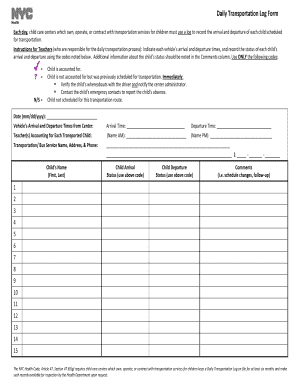

Drivers also must give or mail their original duty status records to their employers within 13 days of completing them. Drivers must carry a copy of their duty status records for the previous seven days and produce them for inspection.
DEPARTMENT OF TRANSPORTATION LOGSHEET DRIVER
The duty status grid must list one-hour increments including "12 noon" and "12 midnight." It must include when the driver was on duty, on duty but not driving, off duty other than in a sleeper berth, off duty in a sleeper berth, driving and on duty but not driving.Įmployers must keep drivers' duty status records (and other supporting documents) for six months. The seven or eight day time period for the driver retaining the log begins from the workplace. The driver's activity record must use her workplace's time zone, be legible and in the driver's handwriting.

In addition to the duty status grid, the daily log form must include: date, daily miles driven, vehicle number, carrier name, driver's signature, 24-hour starting time, main office address, comments, co-driver's name, total hours and shipping document numbers or name of shipper and commodity. The new EOBR regulations, which go into affect in 2012, include new performance standards for the EOBR's, as well as allow the FMCSA to mandate the devices for those companies found non-compliant hours-of-service reporting. On April 5, 2010, new regulations were passed for Electronic On-Board Recorders (EOBR), which differ from AOBRD'S by using global positioning to record information. Until recently, logbooks were only to be completed by hand or with an Automatic On-Board Recording Device (AOBRD). A vehicle that is involved in Interstate or intrastate commerce and is transporting hazardous materials in a quantity requiring placards is also considered a CMV. Is designed or used to transport 9 or more passengers (including the driver) for compensationĥ.

Is designed or used to transport 16 or more passengers (including the driver) not for compensationĤ. Has a gross vehicle weight rating or gross combination weight rating of 10,001 pounds or moreģ. Interstate commerce and fits any of these descriptions:Ģ. In general, a commercial motor vehicle is a vehicle that is used as part of a business and is involved in The driver must record the city, town or village (or truck stop, highway milepost or intersection) when reporting for work, starting to drive, on-duty but not driving or released from work. They ensure drivers aren't driving without proper rest breaks.Įvery driver operating a commercial motor vehicle must track his duty status for each 24-hour period (off, sleeper berth, driving or on-duty not driving) using either an automatic on-board recording device or "Daily Log, Form MCS-59" or the "Multi-day Log, Form MCS-139 and 139A," in duplicate. Department of Transportation's log book requirements are contained in Part 395.8 of the Federal Motor Carrier Safety Administration's driver regulations, "Driver's Record of Duty Status." It covers 11 elements, from who must carry a log book to what information it must contain to how the timekeeping grids should look.


 0 kommentar(er)
0 kommentar(er)
